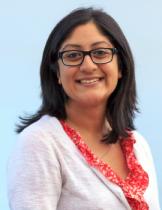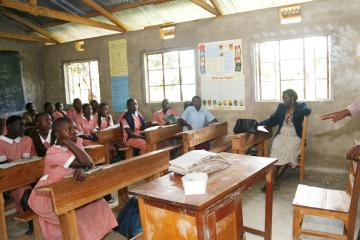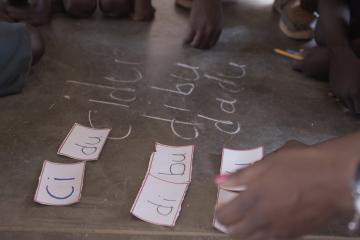
Reflections from seven years of research in J-PAL’s Post-Primary Education Initiative
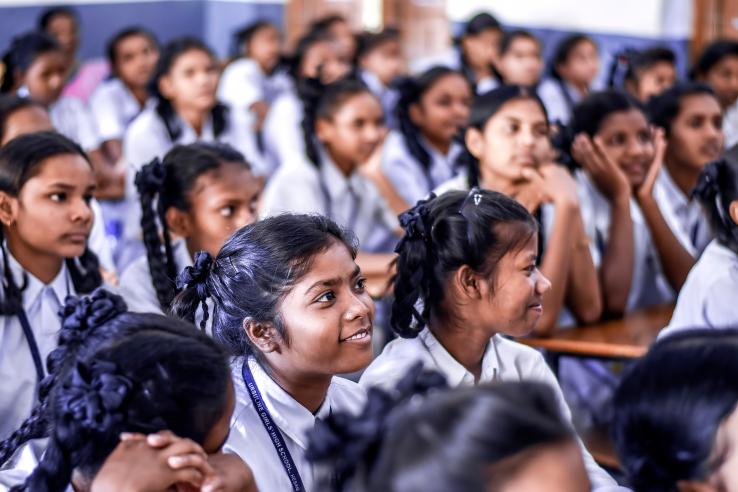
J-PAL’s Post-Primary Education Initiative has funded more than 140 projects since its inception in 2013. We reflect on what we’ve learned through this research—and where we go from here.
Around the world, approximately 200 million students of secondary school age are out of school, and only 36 percent of tertiary school age students are enrolled in higher education. Of those in school, many reach young adulthood without developing the most basic literacy, numeracy, and life skills.
Large surveys in countries like India, Kenya, Tanzania, and Uganda suggest that these learning gaps can trace back to primary school, when children initially fail to master basic primary level skills.
It is also plausible that such learning gaps stem during post-primary education, depending on the relevance of the curriculum, the quality of the teaching, or the types of pedagogical innovations designed to reach marginalized students.
In 2013, J-PAL affiliates and staff members conducted a global review of the evidence on post-primary education to better understand the discrepancies in learning outcomes. They found limited research that could help education stakeholders effectively identify and address the specific barriers restricting the delivery of quality, relevant, and equitable post-primary education.
In response to these gaps, J-PAL launched the Post-Primary Education (PPE) Initiative, with support from the Douglas B. Marshall, Jr. Family Foundation, Echidna Giving, Google.org, the John D. and Catherine T. MacArthur Foundation, and the U.K. Department for International Development (now known as the U.K. Foreign, Commonwealth & Development Office).
The PPE Initiative has sought to generate rigorous, policy-relevant research on open questions across secondary, tertiary, and vocational/entrepreneurial education in low- and middle-income countries. In doing so, PPE has funded randomized evaluations that develop and test innovations across nine priority areas and two cross-cutting themes.
Over the past seven years, the PPE Initiative has allocated over $11 million across 14 regular funding cycles and one COVID-responsive off-cycle round. In total, the PPE Initiative has funded 140 full, pilot, and proposal development research projects to date.
In addition to research grants, the PPE Initiative has funded four policy outreach grants in Argentina, the Dominican Republic, Ghana, and Turkey to support the dissemination of rigorous evidence on topics such as soft skills and education technology.
Contributions to global knowledge
The PPE Initiative has made great strides to increase the quantity, quality, and diversity of rigorous research produced.
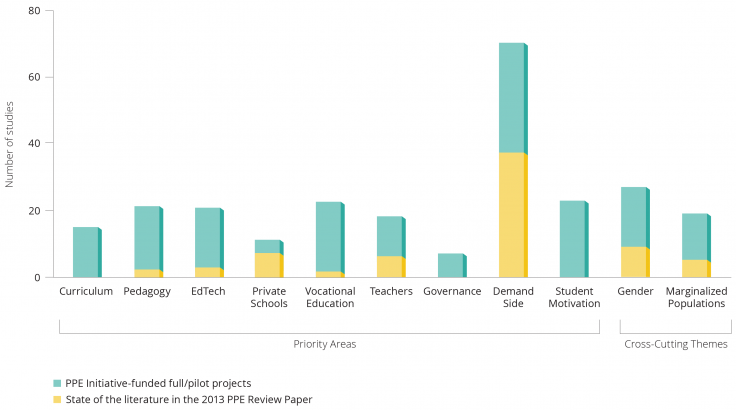
Looking across PPE’s key priority areas and cross-cutting themes, since the release of J-PAL’s PPE evidence review in 2013, the PPE Initiative has doubled the number of existing PPE randomized studies focused on teachers.
Similarly, the number of PPE evaluations on vocational/entrepreneurial education has risen from 1 to 23, the number of pedagogy-focused studies has increased from 2 to 22, and PPE evaluations on topics such as curriculum, governance, and student motivation/effort have since emerged.

The PPE Initiative has funded research in 31 countries across all regions of the world.
Tangible impacts on policy
Several drivers of impact that play a role in improving access to and quality of primary education also help motivate and inform our knowledge and understanding of post-primary education. As such, PPE-funded studies have not only added to the global evidence in education but have also contributed to key open questions in post-primary education and led to findings applicable to policy decisions and scale-ups. We highlight a few examples.
Improving school participation
For a start, the growing global evidence on school participation suggests that when making decisions about investing in education, parents and students often weigh the expected costs and benefits of school enrollment and attendance. Findings from a PPE- and U.S. Department of Labor co-funded randomized evaluation in Peru contributed to one of these lessons in particular: policies and programs that address perception gaps or make the benefits of education more salient increase school attendance at low cost.
J-PAL affiliates Francisco Gallego (Pontificia Universidad Católica de Chile) and Christopher Neilson (Princeton) with Oswaldo Molina (Universidad del Pacífico) collaborated with Innovations for Poverty Action and the Peruvian Ministry of Education to evaluate at scale the effects of informing students about the returns to schooling through telenovela-style videos and an intensive app-based information campaign.
Results suggest that the program was effective at changing students’ educational plans and lowering dropout rates by 1.8 percentage points, all at a cost of less than US$0.05 per student.
The Peruvian government has since adopted and financed the program, which is now part of the national curriculum and has scaled to all urban public schools with full class days. With the ongoing COVID pandemic, the Peruvian government is currently broadcasting the program on national television as part of existing distance learning programs.
This evaluation built on the successes of a similar program in the Dominican Republic, also evaluated by Neilson and J-PAL affiliate James Berry (University of Delaware) with Lucas Coffman (Harvard University) and Daniel Morales (IDEICE). The program decreased student dropout rates, increased students’ national test results, and has since been scaled up by the national government to reach roughly 92 percent of all public secondary schools.
Leveraging education technology to close student achievement gaps
Moreover, the growing body of evidence on student learning indicates that dedicating a portion of teaching time to tailoring instruction to students’ learning levels is an effective and cost-effective approach to closing student achievement gaps and improving overall learning outcomes. A PPE-funded evaluation in Delhi, India, contributes to this body of evidence by demonstrating how education technology can be leveraged to deliver personalized instruction to students.
J-PAL affiliates Karthik Muralidharan (University of California, San Diego) and Abhijieet Singh (Stockholm School of Economics) with Alejandro Ganimian (New York University) evaluated the impact of vouchers to attend a personalized, technology-aided afterschool instruction program, called Mindspark, on learning outcomes.
Results showed that the 4.5-month intervention improved students’ math and Hindi test scores by 0.37 and 0.23 standard deviations, respectively, thereby demonstrating some of the largest impacts on middle-school learning seen in education research.
Building on these promising results from the after-school supplemental education model, Muralidharan and Singh are also evaluating a subsequent scalable model in Rajasthan, India, which is implemented in schools and substitutes classroom time with the software. This is an ongoing 3-year evaluation, with encouraging evidence of significant positive impacts after one and two years.
Strengthening girls’ empowerment
Furthermore, lessons from a PPE-funded evaluation of the Empowerment and Livelihood for Adolescents (ELA) program in Sierra Leone have answered key open questions related to the long-term effects of social and economic inputs on women’s empowerment. This, in turn, has contributed to a growing body of evidence on women's agency which indicates that soft and life skills training programs, often bundled with other components, can improve adolescent girls’ self-efficacy, confidence, and attitudes toward restrictive gender norms.
Conducted by J-PAL affiliates Oriana Bandiera (London School of Economics) and Imran Rasul (University College London) in collaboration with Niklas Buehren (World Bank), Markus Goldstein (World Bank), and Andrea Smurra (University College London), the evaluation unexpectedly coincided with the Ebola outbreak in 2014-15.
In highly disrupted comparison villages, the crisis resulted in younger girls spending significantly more time with men, leading to a rise in out-of-wedlock pregnancies and a persistent 17 percentage point drop in school enrollment post-crisis.
These adverse effects on enrollment were halved in ELA villages, allowing girls to spend time away from men, thereby reducing out-of-wedlock pregnancies by 7 percentage points and enabling them to re-enroll in school post-crisis. A long-term follow-up in 2019-20 showed that impacts persisted, and girls from ELA villages were more likely to select partners who were more educated and more averse to gender-based violence.
Results from this study have become increasingly important in the COVID-19 context, when girls are particularly vulnerable to dropout and other pandemic-related challenges.
Measuring the long-term benefits of secondary education
Finally, given the limited rigorous and causal evidence on the impact of education on long-term development outcomes, PPE has funded a number of projects that track the impact of secondary education and vocational programs on policy-relevant outcomes, such as employment, marriage age, fertility, and wages, among others.
One evaluation conducted in Ghana by J-PAL affiliates Esther Duflo (MIT), Pascaline Dupas (Stanford), and Michael Kremer (Harvard) found that providing scholarships for secondary school led to improvements in educational attainment, knowledge, skills, and preventative health behaviors, 11 years after the scholarships were awarded. Women who received the scholarships delayed marriage and pregnancy compared to their non-recipient peers.
Findings from this study have also contributed to a broader body of knowledge on how reducing costs, such as eliminating school fees or providing small incentives like free uniforms, can lead to large increases in school participation.
As very few studies measure the causal impact of education on long-term outcomes, results from such studies not only fill key evidence gaps but also strengthen the evidence base on the causal returns to education.
Looking ahead to a broader Initiative
Finding ways to respond to the COVID-19 pandemic and support school systems as they reopen is a pressing challenge that must be met in the context of severe budget constraints, insufficient crisis preparation, and persistent gender and socioeconomic gaps. After seven years focused on post-primary education, we are excited to announce two broader requests for proposals, supported by the Douglas B. Marshall Jr. Family Foundation and Echidna Giving, to address these challenges.
The first request for proposals will launch the week of November 9 and will be run in conjunction with J-PAL’s Innovation in Government Initiative. Proposals seeking funding for either research or scale-ups in education will be eligible to apply to this one-time joint call.
These rounds will broaden in scope to include all grade levels from early childhood to tertiary education, but will narrow in focus to generate particularly timely and relevant knowledge to inform COVID response and recovery. We are especially seeking proposals focused on remote/distance learning, girls’ education, and remedial education. Proposals for research or scale-ups of strategies that improve other aspects of education systems to build resilience against future crises are also encouraged.
In the future, J-PAL aims to launch a larger expanded research initiative which funds policy-relevant research across all grade levels. Stay tuned for updates!

